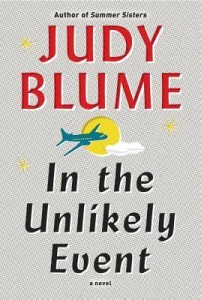 Like most children born in the 1970s and 1980s (and I hope, the 1990s), Judy Blume books made frequent and prolonged appearances in my household. My personal favorites were always the Fudge books. I was (and still am) a lover of scatological and body humor, so Fudge eating his brother Peter’s turtle always appealed to me on a base level. And of course, Are You There God? It’s Me, Margaret was there to ease me into puberty and ask all the awkward questions.
Like most children born in the 1970s and 1980s (and I hope, the 1990s), Judy Blume books made frequent and prolonged appearances in my household. My personal favorites were always the Fudge books. I was (and still am) a lover of scatological and body humor, so Fudge eating his brother Peter’s turtle always appealed to me on a base level. And of course, Are You There God? It’s Me, Margaret was there to ease me into puberty and ask all the awkward questions.
I never got around to reading her adult stuff, or even that classic of teenage sexuality and banned bookdom, Forever, but when I heard that she was releasing a new adult novel, I was immediately in without evening knowing the premise, which turned out to be tantalizing. Allow me to have a Sophia Petrillo moment here. Picture it: Elizabeth, New Jersey, 1951. A series of airplanes fall from the sky over a period of about six months, traumatizing the small town and its residents.
What’s really interesting about this premise is that it’s based on true events, and what’s more, true events that actually happened to Judy Blume. She lived in Elizabeth during the year the planes fell from the sky, and one can surmise by reading this book that it’s something she’s never really stopped thinking about since.
The majority of the book takes place in 1951 and 1952, following a medium sized cast of characters. Objectively, the main character is Miri Ammerman, a fifteen year old Jewish girl who is quite happy with her life. She has a best friend, a surrogate family to go with, she loves her school, and even though she’s never met her father, she loves her beautiful mother and her uncle and grandmother, who all live together. She’s even got a new boyfriend. And then the planes start to crash, and everything begins to fall apart. I say that objectively Miri is the main character, because the frame narrative–which takes place thirty-five years later is told from her perspective–and because, of the characters in 1951-52, she’s the one we spend the most time with, but there are also about ten to fifteen other characters who get POV sections, including some victims of the downed planes.
This is actually one of the things about the book that didn’t really work for me. Blume often switches the POVs after a relatively short time with each character, so I didn’t have very much of a chance to get comfortable in any of their voices. It’s also very disorienting at first as you struggle to figure out who’s who in a world where a lot of people have very similar names (it was the 1950s and everybody was named Fred or Henry or whatever).
The writing was really engaging, and there were parts of the novel that were completely unputdownable. I think Blume really nailed the sections to do with the crashing of the planes, both during the events themselves, and having to do with the trauma that affects the characters. It affects them all in different ways and changes the way they act and think about the world. I also really liked that it was essentially historical fiction. The whole vibe of the 1950s with its post-war paranoia and burgeoning domestic idealism/hypocrisy was very, very present. She also gets the dynamics between people very right, whether its new or old romance, female friendships, or the love between parents and children.
But the whole thing just felt too spread out for me. It never coalesced into a whole story, and I couldn’t figure out what the larger point of it was. I could probably make some educated guesses, but nothing ever clicked for me. I never felt this book on a deeper emotional level than surface entertainment. Which makes me sad.
This book is definitely worth a read, especially if you’re a Judy Blume fan. But mostly it made me want to read her entire back catalogue. Which I might actually do now . . .
[3.5 stars]
